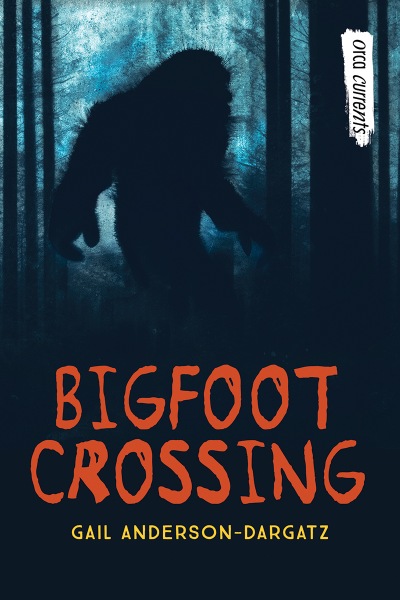In this article, author Gail Anderson-Dargatz reveals the inspiration behind her latest novel Bigfoot Crossing.
As I was walking in my local park one day, I came across a sign tacked to an outhouse. It was titled “BC Forest Service Bulletin. Sasquatch Alert.”
It went on to say, “Attention, visitors: Sasquatch have been sighted coming down from the mountains to feed on fish, freshwater clams and vegetation. DO NOT BE ALARMED IF YOU HAVE AN ENCOUNTER.”
And then the poster offered tips on what to do should you run into a Sasquatch. “Remain Calm. Do Not Run. Do Not Separate from Your Group. Do Not Chase Sasquatch. Do Not Feed Sasquatch. Do Take Photos.”
There was a sketch of a Sasquatch and a last bit of text: “Sasquatch are not aggressive, nor will they harm you.”
Was this poster real? No, it was somebody’s joke, a take on common notices about what to do when encountering wildlife in the area.
But it made me laugh, and I knew I had the start of a novel I would eventually call Bigfoot Crossing.
Are Sasquatch real? Living in rural British Columbia, I’ve been asking myself that question my whole life. I grew up hearing stories from my parents and others about their own Sasquatch encounters. My parents, who were sheep ranchers, spent a lot of time in the mountains. There, they told me, they sometimes heard strange apelike calls and hoots. My dad was a real mountain man and knew almost everything about the animals in the region. These calls, he said, weren’t like any animal he knew of. He felt it might well be Sasquatch.
There were huge apes that have gone extinct. One of them was a giant ten-foot-tall ape called Gigantopithecus that might have been related to the orangutan. And there have been other animals we thought had died out but were later found alive. Maybe Sasquatch is one of them. I like to think so.
If Bigfoot do really exist, was anything on that poster I saw at the park useful? Most of it is good advice. You never want to feed wildlife. It’s dangerous to do so. And it can be very dangerous to approach a wild animal, much less chase it.
How about that last bit of text on the poster that says Sasquatch are not aggressive? Well, no one knows for sure, but other apes, like chimpanzees and gorillas (and us), can be very aggressive. So my guess is that Sasquatch could, in fact, attack a human, if provoked.
In fact, there have been many reports of Sasquatch throwing rocks at humans. I got the idea that Stomp, the Bigfoot in my novel, throws rocks at the shack from a story about a Bigfoot attack at Ape Canyon, near Mount St. Helen’s, in 1924. You’ll find this story all over the internet, but it was originally reported in a newspaper called The Oregonian on July 16, 1924. In the story, miners said they were attacked by “gorilla men” who walked upright and were covered in hair. But later a ranger claimed the rocks were thrown by kids camping nearby.
So who knows? Some people believe Bigfoot exist. Some, not so much.
But here’s the thing. Giant, carefully woven nests like the one my character Jay finds in Bigfoot Crossing have been found in Washington State. They are very much like the beds built by gorillas, orangutans and chimpanzees. It looks like a giant ape built them—but in the Pacific Northwest. You can see them for yourself in the Daily Planet video called Discovering Bigfoot’s Nest on the Discovery Canada YouTube channel (posted March 9, 2017).
Do I believe in Bigfoot? Let’s just say I make a point of carrying my phone on my walks so if I do see one, I can take a picture. But would I share that photo on social media? Nope, I don’t think I would. Just like Jay in Bigfoot Crossing, I’d rather leave the Bigfoot alone to live out their lives undisturbed in the forest.
About Bigfoot Crossing
Jay’s dad loves hunting for Bigfoot, but searching for a mythical creature in the dark isn’t Jay’s idea of fun. Especially because he always gets stuck looking out for his little sister while his dad plays with the cool gear, like night-vision goggles. But while out on a camping trip, a large creature starts hunting them, and then Jay’s father goes missing. Jay is forced to start tracking the creature himself while still keeping his sister safe. It turns out that not only is Bigfoot real but it isn’t the only threat in the woods. There’s a different kind of monster out here, one who is armed with a gun. Jay must act fast to save his father before it’s too late. And he needs Bigfoot’s help to do it.
This high-interest Orca Currents book is written specifically for middle-schoolers reading below grade level. Publishing February 14, 2023.
About the Author

Gail Anderson-Dargatz is the award-winning author of over a dozen books, including The Cure for Death by Lightning and A Recipe for Bees, which were finalists for the Scotiabank Giller Prize. She has also written a number of short novels for striving readers, including the Orca Currents titles Iggy’s World and The Ride Home, which was shortlisted for a BC and Yukon Book Prize. Gail lives in the Shuswap region of British Columbia.

